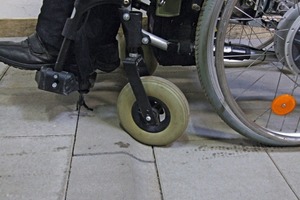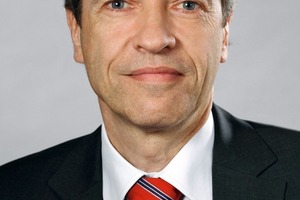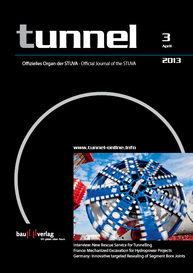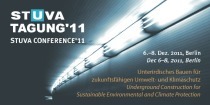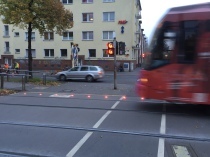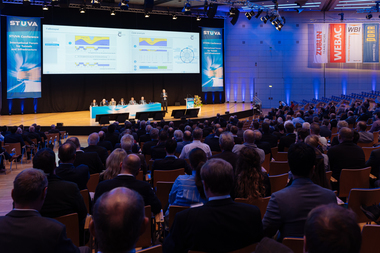STUVA successfully concludes Tests with Probands on barrier-free Design of Crossing Points
The barrier-free design of crossing points plays a decisive role for accessibility and useability of road areas to assure accessible routes for persons restricted in their mobility. The number of persons with impaired ambulation and vision is increasing mainly on account of demographic change. As a result, the number of persons, who are capable of overcoming the current kerb stone edge fixed height of 3 cm only with difficulty or can sense this safety, is growing. The 3 cm mark represents a compromise between the requirements of the blind and persons with impaired vision as well as people with restricted mobility (Fig. 1).
The STUVA has undertaken numerous tests with different methodical approaches in conjunction with the Institute for Transport and Spatial Planning at Erfurt University of Applied Sciences (IVR) and the Ingenieurbüro für Systemberatung and Planung GmbH (ISUP), Dresden delving into the conflict of maintaining as flat a structure as possible negotiable with walkers using as little strength as possible and easily identifiable by touch. The project is aimed at further developing the approaches for designing crossing points (kerb stone and ground indicators) on main highways taking the requirements of blind, visually impaired and ambulatory-restricted persons into account. In this way it is intended to diminish existing conflicts even further.
One of the main aspects of the research project constituted having kerb stones and ground indicators set up on the trial sections established for this purpose in the STUVA testing facilities assessed by people with and without handicaps. Furthermore extensive objective measurements were executed. The trials with the probands were successfully concluded and were received positively by all those involved. In the process, the test persons took avail of the opportunity to try out the difficulties experienced in each case by the other group for themselves: blind persons were able to find out just how difficult it is to negotiate a kern stone with a walker and people with sight were able to attempt to orientate themselves with ground guidance systems using a walking stick. Even those probands, who were not disabled, were able to discover the difficulties they might themselves experience later in life. In this way, the reasoning behind the need for compromise solutions and their further advancement was fostered.
The recommendations derived from the test are being processed for inclusion in the codes of practice. The implementation of accessibility and standardisation represents a further important element for sustainable and in turn, future-oriented road space design taking aspects such as equality for all and limited financial resources on the part of the road-building authorities into consideration.
The project is sponsored by the Federal Ministry for Transport, Building and Urban Development /BMVBS) (FE-No. 77.0500/2010) and the Federal Highway Research Institute (BASt).
Representatives of the needs of handicapped people participated in the responsible committee and in evaluating the results thus ensuring extensive involvement in the project.
For this purpose, the Federal Competence Centre for Accessibility Inc. (BKB) established a self-financed project headed by the German Society for the Blind and People with Impaired Sight and the Institute for Barrier-free Design and Mobility of the VdK welfare organisation. The extensive level of participation also aided the results of the project to be widely accepted.
The closing report with recommendations on the barrier-free design of crossing points on main highways is scheduled to be completed by mid-2013.
Dipl.-Ing. Otto Schließler turns 60
Dipl.-Ing. Otto Schließler celebrated his 60th birthday at the end of last year. Herr Schließler heads the Foundation Engineering Office of the City of Dortmund and the expert commission on public commuter transportation of the German Association of Cities as well as being a member of the German Academy for Urban Construction and Regional Planning. He has been a member of the STUVA board since 2007 and was elected to be its 2nd deputy chairman by the general assembly in 2011.
The STUVA team would like to convey its best wishes on the occasion of this anniversary. We are delighted by the many ideas and suggestions that Herr Schließler has contributed to the work of the STUVA and are pleased to number him among our ranks. We take this opportunity to express our particular appreciation to Herr Schließler for his commitment to STUVA’s requirements.
STUVA Conference 2013
The next STUVA Conference will be staged from Nov. 27–29, 2013 at the International Congress Centre in Stuttgart (ICS), Germany. The conference will be captioned “Tunnels – Infrastructure for the Future” and is thus very much geared to the “Stuttgart 21” mega project. Some 1,500 tunnelling experts from more than 20 countries are expected to turn up. This means that “the family meeting for tunnellers” organised by the STUVA is numbered among the world’s leading get-togethers for underground construction.
Some 40 papers will be presented dealing with current technical development in all sectors of underground construction, planning, building, redevelopment, retrofitting, research, safety during construction and operating tunnels, economy, drawing up contracts, financing and current involvement of citizens in major projects. “Stuttgart 21” will be focused on extensively at the conference commensurate with the significance of the project. Various aspects will be honed in on and we invite you to inspect this interesting construction project on the spot. The gala evening on Day 1 provides the chance to continue the discussions, which began in the course of the day, in a relaxed atmosphere, to consolidate existing contacts and initiate new ones.
The accompanying exhibition, which registers ever increasing growth rates per year, is staged in direct connection with the series of lectures. Products and services from the fields of execution, the supply industry, planning and consulting on the foundation engineering and tunnelling sector will be presented to the trade by what are now more than 130 companies from home and abroad.
On going to press more than 1,700 m² of exhibition space had been sold. All relevant details are available by accessing
//www.stuva-expo.de" target="_blank" >www.stuva-expo.de:www.stuva-expo.de.
Technical excursions on Day 3 round off a perfect mix of specialised further training, networking event and marketing platform. Interested conference participants are invited to obtain a greater insight into the Stuttgart 21 mega project on the spot.
The call for papers was sent to the STUVA members in December 2012 and at present the conference programme is being compiled in accordance with the resolutions of the external selection board followed by approval from the STUVA board. The programme will be published roughly at the end of April 2013 on
//www.stuva-conference.com" target="_blank" >www.stuva-conference.com:www.stuva-conference.com. It is also possible to register for the conference from the end of April. At the end of May, the printed programme booklet is available from the STUVA office. The complete programme will also appear in one of the next issues of this publication.

